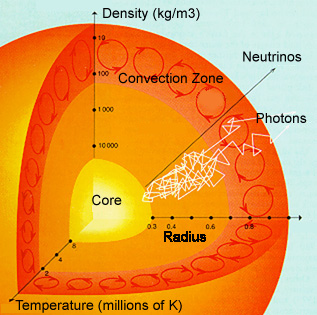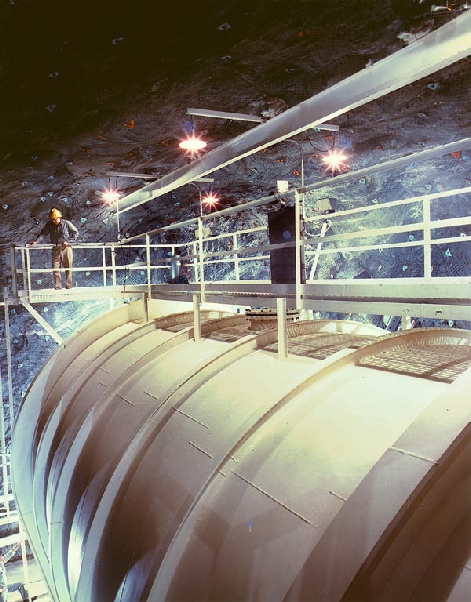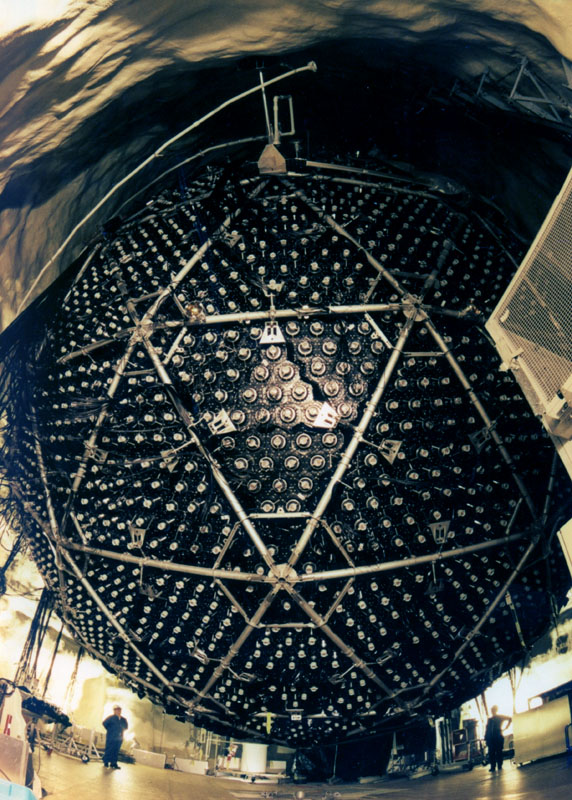Stellar Structure Equations |

|
Stellar Structure Equations |

|
I. Mass Conservation
II. Momentum Conservation: Mechanical Equilibrium or Hydrostatic Equilibrium
If the star is in hydrostatic equilibrium, the star neither expands nor contracts; it sits nicely in some equilibrium configuration. This means that the forces which control the star are precisely balanced and so
For stars:
Stars maintain themselves in hydrostatic and thermal equilibrium; they just sit there merrily chugging along. The regions in the HR diagram where we see clumps of stars are regions where the stars are roughly in hydrostatic and thermal equilibrium.
The important question of the energy source of the Sun is a longstanding one which was not answered satisfactorily until the twentieth century. We now discuss Nuclear Fusion as the source of Solar power. A final point must be made. The Sun (and stars) generate energy in their cores (their central regions). So, in order to maintain thermal equilibrium, the energy must be distributed throughout the Sun (the star). What are the modes of this energy transport?
An important test of our ideas (as discussed earlier) concerns the detection of the ghostlike particles known as neutrinos.
 |
Solar Neutrino experiments were started in the 1960s by Brookhaven scientist, Ray Davis to verify that we understood how the Sun worked. No one thought that the experiment would that interesting; it would be difficult but the result would not be surprising. It came as a rude surprise when Davis's experiment detected fewer neutrinos than predicted by the best models of the Sun, throwing doubt onto whether we really did understand our Sun. Follow-up experiments also found ~1/3-1/2 of predicted neutrinos. |
 |
This conundrum persisted for ~35 years until the early 2000s when, first, the Super-K (Super Kamiokande) experiment showed neutrinos were chamaeleon-like in nature. Neutrinos, once produced, could change into forms undetectable by the early experiments. The SNO (Sudbury Neutrino Observatory) experiment, able to detect transmuted neutrinos, then came online and detected the predicted number of Solar neutrinos. The amusing result was that a simple observation of the Sun led us to a deeper understanding of how the Universe works on the sub-nuclear scale!
These important experiments showed that we have a good understanding of the Sun. As a major benefit, it also expanded our understanding of the properties of neutrinos, some of the fundamental particles which make up our Universe. For the more technically minded, the late John Bahcall's website www.sns.ias.edu/~jnb contains a very good discussion of Solar neutrinos and the Solar model.

Solar oscillations are another sensitive probe of the interior of the Sun. Go to the website http://gong.nso.edu/info to find more information on the Global Oscillation Network Group, GONG.
The Sun is like a bell in that if you kick it, it rings. The source that excites the most of the observed Solar oscillations, is the convective layer and so, the Sun is like a bell that is continuously buffetted by many small kicks. The GONG experiment detects and studies the different ways in which the Sun rings. The exact manner in which the Sun rings is determined by the details of its interior structure (in particular, by the details of the convection layer). So, studying the way in which the Sun rings gives us another way to study what the Sun looks like beneath its surface. (The technique is similar to that used by geologists who use seismology to study the interior of the Earth. For the Sun, the science is called helioseismology.)
The Sun rings in many different ways depending on the details of the interior of the Sun, the sound waves bounce around and travel through the Sun in different ways and with different speeds. Some rattle around near the surface of the Sun, some are trapped in the convective layer of the Sun, and some stretch to the center of the Sun. (The motions generate sound waves -- The Boiling and Singing Sun.)
Scientists model these waves finding things which look like (the "cells" represent where the waves bounce off the surface of the Sun, and so on [see the above picture]). The following mpeg movie show Solar oscillations.
The current GONG results (depend on the sound wave speeds [the sound speed] and other aspects of the ringing) compare well to the predictions made by current Solar models. The GONG site's K-3 link is a little low-level, but is amusing.